GASTRONOMY OF CHIAPAS
Typical Food of CHIAPAS
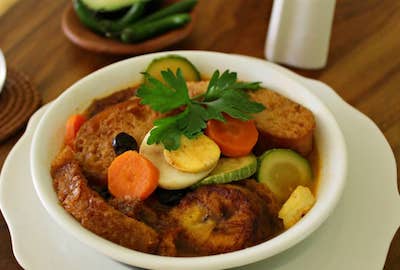
The Cuisine of Chiapas is the result of cultural fusion between Spaniards and natives with a result of exotic flavors. The typical dishes integrates elements of the Hispanic and Spanish cuisine. Each region of Chiapas has its specialty, but some of the most famous are: the tamale made of masa (a starchy dough, usually corn-based) and seasoned with spices sweet, salty, spicy and regional fruits, the pictes or corn tamales, the delicious barbecue beef or lamb, the palatable pig (baked pork) or the peculiar chainfaina (made with pork and beef) black beans with salted beef, and the sispolá (beef with chickpeas and cabbage).
This rich gastronomy has also delicious drinks like Chía water and Pozol (fermented corn dough), either white or with cocoa. In the area of Comitan you can have a refreshing drinks like Comiteco (fermented maguey drink) and the agua de tzilacayote, a drink made with a special regional fruit like mango, tejocote (small crab apple-like fruit) and plum. And of course, The Soconusco and Los Altos (Highlands), region offers a worldwide known coffee for their delicate aroma, medium body, natural chocolate flavor and bright acidity.
Each region has its own specialities and variations.
- In Tuxtla Gutierrez, the corn-based dishes are the most common as tascalate (a drink made with corn, chocolate, nuts and vanilla) and tamales.
- In SanCristóbal de las Casas, specialties are based mostly on tcured meats such as ham and sausages, which are of Spanish origin, as well as sweets such as crystallized fruit and coconut candies; local specialties.
- In Chiapa de Corzo, includes a suckling pig roasted seasoned with dried chilies and spices.
- Palenque is known for many versions of fried plantains, including filled with cheese, and for the shuti broth (small freshwater snail cooked in a broth flavored with hoja santa).
- in Tapachula, chipilin with shrimp and pictes, a fresh sweet corn tamale with cheese and sugar.
- In Tonalá, seafood is a strong component in many dishes like the macabil sausages and the famous tamales juacane (filled with a mixture of black beans, dried shrimp, and pumpkin seeds).
- In Comitán, the chinculguaje, dough filled with beans and cheese, and the hearts of palm salad in vinaigrette. Cheese making is important, especially in the municipalities of Ocosingo, Rayon and Pijijiapan.
- Ocosingo has its own self-named variety, Queso Bola, a cheese with strong flavor with a creamy, crumbly texture. It is quite popular among restaurants and gourmet shops along the country.
You can enjoy the cuisine in Chiapas. One suggestion for food is to accompany tourists listening to the harmonious sound of the instrument’s most historic and popular in this region: the marimba.
Traditional Dishes of CHIAPAS
Chiapanecan Chipilín Tamales
Tamales are a ubiquitous part of Mexican cuisine and are a must-try for anyone visiting Chiapas. The Chipilín Tamales, in particular, are a favorite of locals and tourists alike. Made from corn dough and stuffed with scrambled corn and chipilín leaves, these tamales have a distinct flavor that sets them apart from other tamales in the region. Chipilín, a plant that grows in abundance in Chiapas, is a staple in the local cuisine and adds a unique flavor to any dish it is added to. The tamales are steamed to perfection and served hot with a side of salsa.
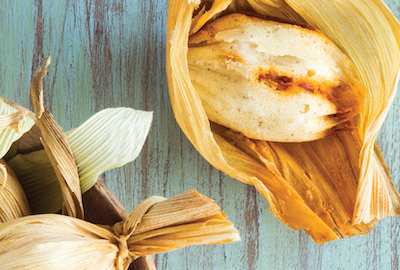
Apart from the Chipilín Tamales, Chiapas has a range of other tamale varieties that are worth trying. The Mole Tamale, made with a savory sauce of chilies, spices, and chocolate, is a classic Chiapanecan dish that is perfect for anyone who loves bold flavors. The Saffron Tamale, from the city of San Cristóbal de las Casas, is another must-try for anyone visiting the region. With its bright yellow hue and fragrant aroma, this tamale is a feast for the senses. The Tamal de Cambray, a sweeter variant of the tamale, is found in the coastal areas of Chiapas and is perfect for those with a sweet tooth. Finally, the Ball Tamale, made with two types of corn dough and stuffed with the Simojovel chile, is a culinary symbol of the town of Simojovel de Allende.
Tamal de Bola (Ball Tamale)
The tamale played a preponderant role in the food and ceremonials of the pre-Hispanic Chiapas Maya, as evidenced by the hieroglyphics deciphered in Palenque, the main archaeological zone of the state.
The Mayans placed 3 or 4 tamales on a plate in the tombs as offerings to the dead, as well as kitchen utensils decorated with images of the ancient food. In Chiapas a great variety of tamales are made and one of the most popular is the ball one, prepared with two masses of corn of different texture, which gives them a particular charm, along with the simojovel chili, a culinary symbol of the Chiapas people of Simojovel de Allende.
Sopa de Pan (Bread Soup)
This typical Chiapas soup was introduced by the Spanish and was the traditional food of San Cristóbal de las Casas on the eve of Holy Week, and is also called fiesta soup. It is still a dish eaten in regional religious celebrations and the recipe has been enriched over time.
These days, a good fiesta soup should have coleto bread, raisins, sliced boiled eggs, plantain, and green beans. Saffron, oregano and thyme are used to flavor and color. In 2006, during the San Cristóbal de las Casas Spring and Peace Fair, they prepared an immense bread soup that entered the Guiness Book of Records.
Cochito Horneado (Baked Pig)
The baked pig gastronomically presides over the January Festival of the Chiapa de Corzo city, also called the Grande Festival, a celebration that takes place between January 8 and 23. During these festivities the show of Los Parachicos is presented, one of the most colorful dances in Mexico.
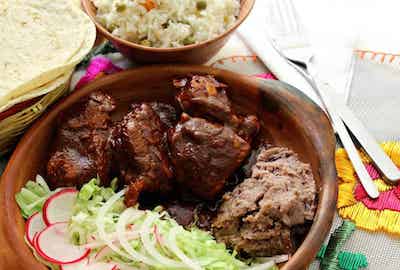
Everyone eats a car in Chiapa de Corzo on January 22, the eve of the final day of the fair. It is baked pork, seasoned with a sauce in which various spices, aromatic herbs and ancho chili participate. It is accompanied with a broth called recado, lettuce and onion.
Queso de Ocosingo Relleno (Stuffed Ocosingo Cheese)
This recipe is prepared with the most popular ball cheese in Chiapas, a product originally from the Chiapas municipality of Ocosingo, which is made with cow’s milk curd. To fill the cheese, a hole is made in it, leaving a border about a centimeter wide and the extracted material is reserved. A stew of ground pork is made with tomatoes, onion, olives, serrano peppers, chopped almonds, aromatic herbs and spices.
With the hot stew, add lightly beaten egg and the cheese extracted from the ball, mixing until everything is integrated. The cheese is stuffed with this stew and a final steam cooking is done in a water bath.
Huevos a la Chiapaneca (Chiapaneca-style eggs)
Chiapaneca-style eggs are a dish that is very often present in the breakfast of the people of Chiapas. Aside from the eggs, the main ingredients in the recipe are soupy pot beans and toasts. The tostadas broken into pieces are fried together with the eggs and the pot beans are added. The usual accompaniments are slices of cheese and avocado, cream, slices of chili and chopped onion.dish that is not for the faint-hearted but is an experience that is not to be missed.
Chalupas Coletas
The chalupa is a snack generally made up of a tortilla and a sauced filling, which Mexicans usually eat at night and very particularly on September 16, Independence Day. The Chalupas Coletas are from San Cristóbal de las Casas and their traditional filling is made of pork, although there are also chicken.
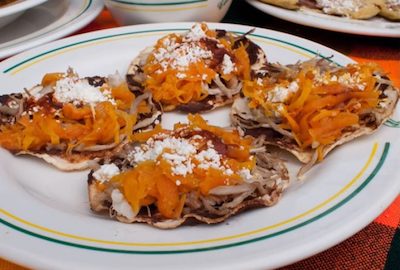
Whether it’s a piece of pork loin or a chicken breast, the meat is cooked with spices and shredded. The tortillas are browned in a skillet and spread with refried beans. Finally, the meat is put on the tortilla, along with grated carrots and beets and crumbled old Chiapas cheese. The chalupas are salted with pico de gallo.
Mole Chiapaneco (Chiapas Mole)
Although it is not as famous as the Poblano or Oaxaqueño, the Chiapas mole is part of the culinary tradition of Chiapas and is in high demand in popular food stalls and restaurants. Chiapaneco mole is made with deveined and seedless ancho peppers so that they are less biting, which are soaked in a hot chicken or turkey broth, which gives them a rich flavor. This mole also has peanuts, tomato, onion, thyme, raisins and chocolate. In some versions, biscuits, white bread and fried banana are added.
Chiapas Nucú
If you are feeling adventurous and want to try something truly unique, then the Chiapas Nucú is the dish for you. Nucú is a species of leaf-cutter ant that is native to Chiapas and is a recurring food item in the local cuisine. The ant is roasted on a comal or pan and then eaten with salt and lime. The dish is often served as a snack or as a taco filling. The ant is also used in tamales and some local alcoholic beverages. The Chiapas Nucú is a dish that is not for the faint-hearted but is an experience that is not to be missed.
Traditional Sweets and Desserts of CHIAPAS
When it comes to culinary delights, Mexico is a country that is often celebrated for its rich flavors and unique dishes. One such state that is known for its vibrant and diverse cuisine is Chiapas. From hearty meals to mouth-watering desserts, the food culture of Chiapas has something for everyone. In particular, the sweets and desserts of Chiapas are a must-try for anyone visiting the state.
Chimbos
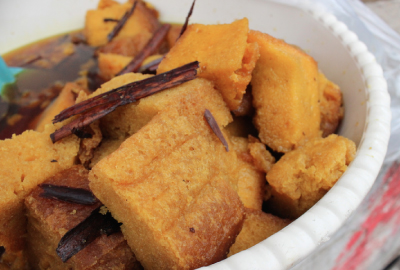
One of the most popular desserts in Chiapas is Chimbos, a small bread soaked in a mixture of honey, cinnamon, and anise. This dessert originated in the 1970s in the municipality of San Cristóbal de las Casas and Comitán when the convents needed to make a simple yet delicious bread for long religious ceremonies. The Chimbos were served in churches as an appetizer for companions, and over time they gained popularity in the surrounding municipalities. Today, Chimbos can be found throughout Chiapas.
Nanche Curtido (Tanned Nanche)
Nanche, also known as nanchi, is a fruit that is common throughout Mexico, but due to Chiapas’ warm climate, it is especially prevalent in the state. The fruit is about 1 cm in diameter, similar to olives, with a round shape and a vibrant yellow color. While the inhabitants of Chiapas usually consume the fruit in its natural form, the ‘Tanning’ process was created to preserve the fruit for longer and give it a different flavor. To tan nanches, a container is filled with the fruit, and sugar is poured over them, with no free spaces left. After several months of rest, the sugar turns into liquid, and more sugar is added. This process can take up to two years to complete. While some people tan their nanches with alcohol, the same result can be achieved with pure sugar. Tanned nanches can be found throughout Chiapas.
Muéganos
Muéganos have their origins in the Zoque culture, who created small loaves seasoned with sugar and crowned with rosé. These sweet treats can be enjoyed in the markets, parks, streets, and even shopping malls in Chiapas. Muéganos are prepared like any other bread with flour, baking powder, butter, eggs, and milk. They are then molded by hand into a circular or tubular shape and fried in a large vat with oil or butter. After frying and drying, the muéganos are transferred to a pot with melted sugar over low heat, preventing them from sticking together and allowing them to take on the flavor of honey. Finally, the muéganos are dusted with bright pink-colored sugar, giving them a colorful touch.
Yolk Candy
Another must-try sweet in Chiapas is yolk candy, which is famous for its wide range of flavors and shapes. The base of this candy is always the same – egg yolks and sugar – but the flavors differ depending on the place where they are made. Yolk sweets can be found in the shape of animals, flowers, and other designs, and their texture is incredibly delicious.
You can find yolk candy throughout Chiapas in markets, fairs, and squares. If you’re in the city, it’s definitely worth trying this sweet delicacy. Its unique texture and taste are sure to leave a lasting impression.
Coleto Bread
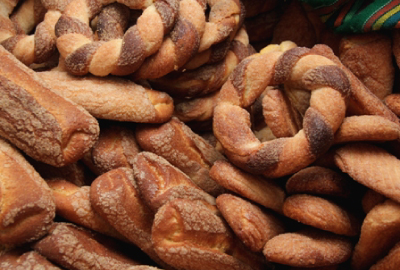
In Chiapas, bread is a beloved staple, and the locals have their own special and secret recipe for it. Coleto bread is a traditional bread that originated in San Cristóbal de las Casas in the 19th century. The bread was created as a way for the natives to trade their excess wheat with other communities without losing their harvest. The recipe for Coleto bread includes wheat flour, eggs, sugar, cinnamon, rough milk, and butter, all mixed and prepared by hand. The bread is then baked on firewood in various shapes, including braids, hoops, shells, and horns.
Today, the tradition of making Coleto bread lives on, and locals begin their work at dawn, distributing large quantities of bread throughout the state of Chiapas by noon. You can find Coleto bread in any market, square, or even on the streets of Chiapas. However, if you want to taste the best, head to San Cristóbal and Comitán. The taste and texture of this bread are unique, and it’s a must-try when visiting Chiapas.
Melcocha
Melcocha is a dessert that is highly coveted in Chiapas, and it’s one of the most desired sweet treats in the region. This dessert is made by melting piloncillo or panela, which is then put through a kneading process to add air and make it fluffy. Peanuts are then added to the mixture, and the dessert is cut into small pieces before serving in dry corn husks.
The key to enjoying melcocha is to eat it fresh, as it’s meant to be enjoyed when it still retains its viscosity. After a few hours of preparation, the piloncillo returns to its solid state, and the dessert loses its unique texture and flavor. To enjoy melcocha at its best, you should visit the markets and squares in the morning to find freshly made taffy.
Cocadas
As one of the largest coconut producers in Mexico, it’s no surprise that cocadas are a staple dessert in Chiapas. This sweet treat is made by mixing shredded dried coconut with melted sugar and adding dyes to create a colorful presentation. The coconut scratch used in cocadas needs to be completely dry and free of water, which is achieved by leaving it under the sun for a few days.
To make cocadas, the dried coconut scratch is mixed with butter, sugar, egg yolks, and a small amount of milk. The resulting mixture is then shaped into different figures and baked in a wood-fired oven. The final product is a soft and smooth textured coconut “cookie” that comes in various shapes and sizes. While cocadas are popular throughout Mexico, Chiapas offers a unique twist by presenting them in a range of vibrant colors.
Milk Marzipan
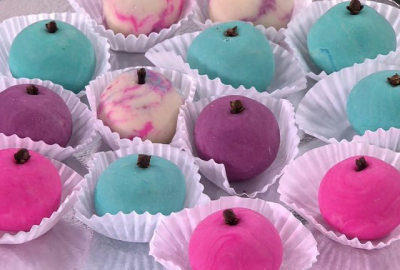
Milk marzipan, also known as “mazapán de leche” in Spanish, is a dessert that’s commonly produced during the Christmas season in Chiapas. This sweet delicacy is made by mixing icing sugar, condensed milk, powdered milk, and dried fruits such as walnuts or almonds. The ingredients are then formed into small balls and coated with powdered sugar to give them a smooth and creamy texture.
Milk marzipan can be found throughout Chiapas during the holiday season and Christian festivities, as well as in local fairs and markets. The dessert is a beloved favorite, especially among children, for its sweet and nutty flavor.
Sweet of Coyol
The sweet of coyol is a dessert that’s commonly eaten throughout southern Mexico, including in Chiapas. The coyol fruit comes from a palm tree known as the “Palma de coyol” or taberna, which is similar in appearance to coconuts. The small, oval-shaped fruit has a yellow skin that turns dark after boiling.
To make the sweet of coyol, the fruit is boiled, and its shell is removed. The boiled coyol is then soaked in honey that contains water, piloncillo (unrefined brown sugar), cloves, and cinnamon. The result is a sweet and aromatic treat that’s both flavorful and unique.
The sweet of coyol can be found in all markets and fairs in Chiapas, making it an accessible dessert for both locals and tourists. It’s a perfect choice for those who want to explore the state’s cuisine and experience its unique flavors.
Pictes
Pictes, also known as ‘Picte de elote, Pictle and tamale de elote,’ are a popular dessert made with shrouded corn kernels mixed with sugar, cream or fresh milk, salt, cinnamon, and vanilla. The mixture is then wrapped in a dry corn leaf and steamed. Although corn tamales can be found throughout Mexico, each state has its own way of preparing them. In Chiapas, pictes are usually accompanied by a good pot of coffee and a piece of coleto bread. Coleto bread is a traditional bread made with flour, salt, and water, which is perfect to balance out the sweetness of the pictes.
Turulete
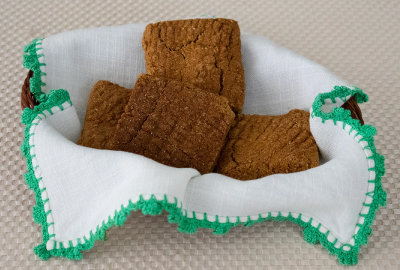
Turuletes are small sandwiches made with cornmeal, butter, sugar, cinnamon, and piloncillo. The mixture is baked over wood and results in a delicious diamond-shaped cookie. People from Chiapas usually eat turuletes as sweet bread accompanied by coffee, chocolate, or atole. Atole is a traditional Mexican hot beverage made with masa (a type of corn dough), water or milk, and flavored with cinnamon and sugar.
In some municipalities of Chiapas such as Tonalá, Tuxtla Gutiérrez, San Cristóbal de las Casas, Chiapa de Corzo, and Comitán, it is quite common to find ladies with huge baskets full of turuletes to sell them on the streets. If you visit Chiapas, don’t miss out on this experience and delight your palate with this little sweet sandwich.
Trompadas
Trompadas are a typical sweet from Chiapas and Oaxaca that have their origins in the colonial era between 1521 and 1810, as a result of Christian religious ceremonies. This dessert is made with piloncillo, milk, coconut, and walnut. To make trompadas, the panela or piloncillo is mixed and melted with milk to form a viscous paste. Then, small balls are made and filled with coconut, nuts, or peanuts, resulting in a creamy sweet with an unexpected filling. Trompadas can be found throughout the state of Chiapas in markets, fairs, and even small grocery stores. They are perfect to enjoy with a cup of coffee or atole on a chilly afternoon.
Traditional Drinks of CHIAPAS
Chiapas is known for its natural beauty, rich culture, and delicious gastronomy. Among the many culinary treasures that this region has to offer, its traditional drinks stand out for their unique flavors and deep historical roots. From corn-based beverages to refreshing chia water, Chiapas has a wide variety of drinks that are not only tasty but also an important part of the state’s cultural heritage. In this article, we will explore some of the most emblematic drinks of Chiapas and their origins.
Pozol
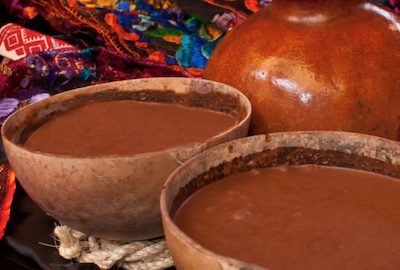
When talking about traditional drinks in Chiapas, pozol is undoubtedly one of the first that comes to mind. This beverage is made from corn and can be prepared in different ways. The most common types of pozol are white corn, nixtamalized corn (cooked with lime), and cocoa-based. To enhance the flavor, sugar or salt can be added, along with chili and ice. Pozol is a very popular drink among locals and visitors alike and is usually consumed at noon or in the morning.
The traditional way of serving pozol is in small earthenware vessels or jícaras, as dictated by the Chiapas tradition. The drink must be stirred frequently to avoid the formation of a “well” at the bottom of the container. In addition to being a refreshing beverage, pozol is also a source of energy and nutrients, making it a popular choice for workers in the field.
Another variation of pozol that cannot be missed is the demolish of pozol, made from white corn. This drink is considered a pre-Hispanic beverage and is very refreshing, sometimes even served as a meal. Chiapas is one of the only states in Mexico where pozol is found, and the 5 different ways of preparing it have become popular. The pozol de cacao is one of the most popular variations.
Tascalate
Tascalate is another traditional beverage of Chiapas that has been consumed for centuries. This drink is made from corn, sugar, cocoa, chili, cinnamon, and achiote, which is used to give the drink its characteristic reddish color. Tascalate can be prepared with water or milk, depending on personal taste.
The preparation of tascalate involves browning the corn and cocoa, grinding them together with the other ingredients, and mixing them with the base. Finally, ice is added to give the drink a refreshing touch. Tascalate is a common beverage throughout the state of Chiapas, consumed at any time of the day, either as a heat reliever or as an accompaniment to a meal.
One of the most interesting facts about tascalate is that it has been consumed since pre-Hispanic times, making it a drink that has been maintained for generations in the state.
Agua de Chía (Chia Water)
Chia seeds have gained popularity worldwide in the last decade due to their nutritional and antioxidant properties. However, in Chiapas, the consumption of chia dates back centuries, when Mesoamerican cultures used it as a refreshing drink. Agua de chía is a typical drink of Chiapas, and its preparation is quite simple. The recipe consists of mixing lemonade with chia seeds and a touch of sugar to soften the flavor.
Despite its recent popularity, agua de chía has been present in Chiapas since ancient times, and it is not difficult to find it in any corner of the state. This refreshing and nutritious drink is a perfect option for those hot days when a boost of energy is needed.
Pox or Posh
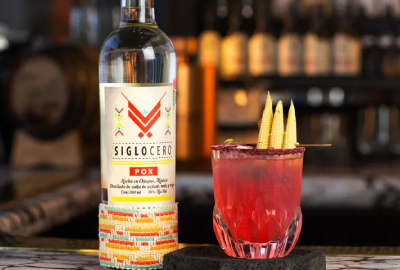
One of the most traditional drinks in Chiapas is Pox or Posh. This alcoholic beverage has been part of the Mayan culture for centuries and is often used in solemn ceremonies as a symbol of union among the inhabitants. The liquor is made from a combination of corn, cane, and wheat and is particularly popular among the indigenous settlements of the Chiapas Highlands. According to indigenous beliefs, Pox has healing properties that provide inner peace, making it a bridge between the material and spiritual world.
If you are looking for an alcoholic drink to properly toast your visit to the state, then El Pox is for you. This Chiapas drink has an ancestral origin and is used in different Mayan ceremonies. Its unique flavor and cultural significance make it a must-try beverage when visiting the region.
Sour Atole
Another characteristic drink of Chiapas is Sour Atole, which is particularly popular in San Cristóbal de las Casas during the winter months. This homemade drink is prepared using black corn, sugar, cloves, and cinnamon, giving it a sweet and spicy flavor that warms you up from the inside out. While other towns in Chiapas prepare Atole with white corn, the unique recipe of San Cristóbal de las Casas sets it apart from other versions.
This drink is a great way to warm up on a cold winter day, and its unique flavor profile makes it a popular choice among both locals and tourists alike. So, if you visit Chiapas during the winter months, don’t forget to try this delicious and traditional beverage.
Poote or Pinol
If you are looking for a refreshing and energizing drink to beat the summer heat, then Poote or Pinol is the perfect choice. This traditional beverage is prepared using corn that has been previously browned and ground, and then cinnamon powder is added. The result is a smooth and pleasant flavor that is perfect for quenching your thirst on a hot day.
You can find Poote or Pinol in Tuxtla Gutierrez, Copainalá, and Jiquipilas, among other towns in the region. Its popularity is due to its refreshing and energizing properties, making it a popular choice among locals and visitors alike.
Balché
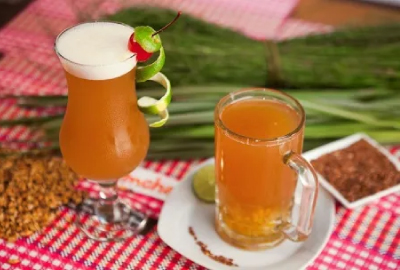
Balché is an alcoholic beverage of Mayan origin that is made by fermenting water and a syrup obtained from the legume Lonchocarpus violaceus. This drink is especially popular in the city of Palenque and is deeply ingrained in the local cultural heritage. The syrup is obtained by boiling the bark and roots of the tree, and then the resulting liquid is mixed with water and fermented for several days.
Balché is a potent drink with a distinct flavor that is best enjoyed in small quantities. The syrup has a bitter taste, which is balanced by the sweetness of the water and the fermentation process. The end result is a drink that is earthy, nutty, and slightly sour, with a subtle alcoholic kick.
Atole de Granillo
Atole de Granillo is a traditional drink that is deeply ingrained in Chiapas’ culinary culture. As with all atoles, the base of this drink is corn, which is boiled in water until soft and then ground into a fine powder. However, what sets Atole de Granillo apart is that the corn is not completely ground, and some pieces are left, giving the drink a unique texture and flavor.
This drink is typically consumed at breakfast or dinner and is especially popular in San Cristóbal de las Casas, where the corn culture has a rich and ancient heritage. Corn is ubiquitous in this city and is used in various forms, including food, bread, dessert, and drink. Atole de Granillo is made by mixing the ground corn with water, milk, cinnamon, and sugar and boiling the mixture until thickened. The end result is a warm and comforting drink that is perfect for cold winter mornings.
Cocoa Champurrado
If you are a fan of chocolate, then you will love the cocoa champurrado, a traditional drink of the indigenous peoples of Mexico. This delicious drink is made with cornmeal, dark chocolate, water, and cinnamon. Although it was derived from atole, it has evolved into its own unique drink with a distinct flavor. The crushed corn dough used in champurrado is originally from Guerrero of the hot land. However, it is more commonly found in San Cristóbal de las Casas, a city in Chiapas.
The preparation of champurrado involves boiling the corn dough and then mixing it with water, chocolate, and cinnamon. The mixture is then simmered until it thickens, creating a rich and creamy drink. Champurrado is typically served hot, especially during the colder months of the year, making it a perfect drink for the winter season.
Mistela
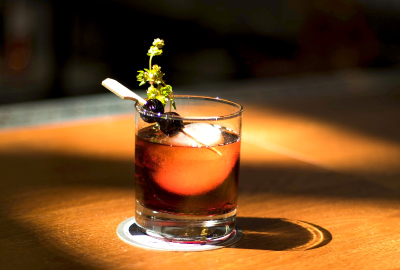
Mistela is a sweet and intoxicating liqueur that is popular throughout Mexico. Although it is traditionally made from grapes, in Chiapas, various fruits are used, which are macerated for a long time in cane alcohol. This drink is especially popular among mezcal lovers and is a must-try for anyone who wants to explore the alcoholic beverages of Chiapas.
Mistela has a rich and complex flavor profile that is sweet and slightly syrupy, with hints of fruit and a subtle alcoholic kick. It is typically served as a dessert drink, either on its own or mixed with coffee or tea. This drink is a testament to Chiapas’ rich cultural heritage and its love for sweet and flavorful beverages.
Chiapas Coffee
Coffee is one of the most consumed beverages in the world, and Chiapas coffee is considered to be one of the best. Chiapas is one of the largest coffee producers in Mexico, and its coffee is renowned for its rich and intense flavor. In fact, local Chiapas coffee brands are sold in popular coffee shops like Starbucks.
Coffee has been a traditional drink in Chiapas for centuries, and it even has its own coffee route where visitors can learn about coffee production and enjoy the breathtaking landscape of coffee plantations. The coffee route is a popular tourist attraction in Chiapas and offers visitors a chance to taste some of the best coffee in the region.
More Tourist Attractions in CHIAPAS
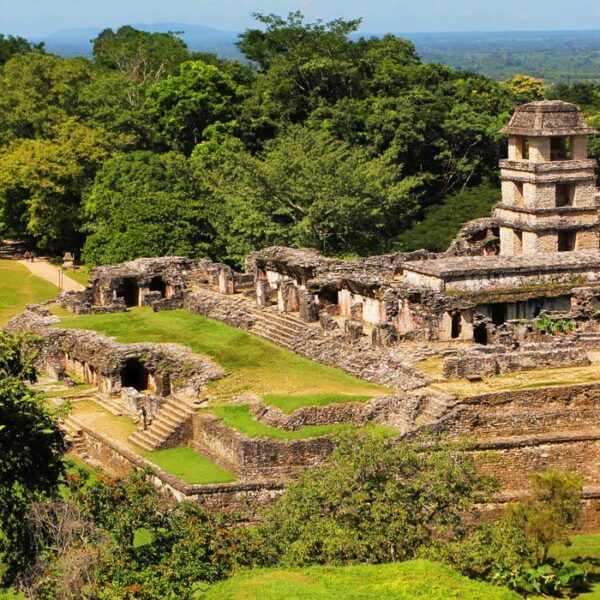
Palenque
Palenque is a Chiapas city of Mayan origin, head of the municipality of the same name located in the north of the state. The indigenous population is formed mainly by the Chol, Tzeltal and Lacandon ethnic groups. The municipality borders Guatemala to the southeast, has three border sectors with the state of Tabasco and is also a neighbor of the Chiapas municipal entities of Catazajá, La Libertad, Ocosingo, Chilón and Salto de Agua. The closest cities to Palenque are Villahermosa, Tabasco, located 145 km to the west and San Cristóbal de las Casas, which is 219 km to the south.… Read More
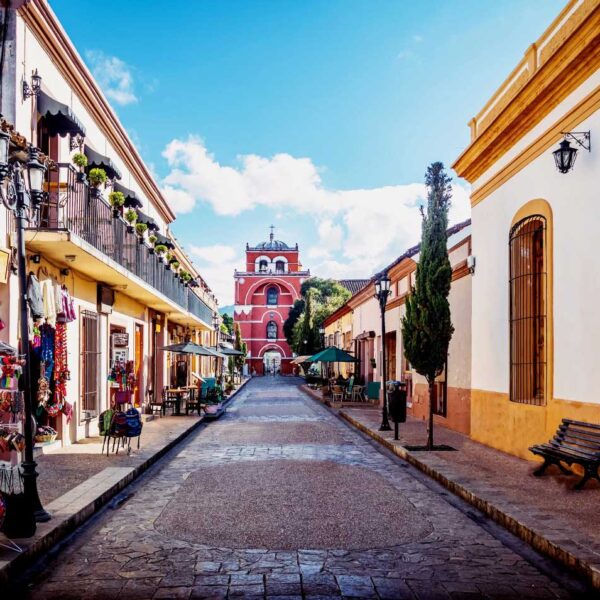
San Cristobal de Las Casas
San Cristóbal de las Casas is one of Mexico’s most beautiful colonial towns. Through its peaceful cobblestone streets, flanked by houses with slanted red tiled roofs and patios full of flowers, one discovers religious monuments with influence from Mexican and Central American colonial art, giving it a peculiar frontier town character. Indigenous people come to its busy markets from the surrounding hamlets to offer textiles, ceramics, fruits and vegetables.… Read More

Ecotourism and Adventure in Chiapas
Ecotourism in Chiapas is currently one of the most popular tourist trends in the state, with activities that try not to alter nature, thus preserving the ecosystem, flora and fauna, while encouraging sustainable development processes in indigenous communities that remain in the region. Responsibly enjoy a vacation in Chiapas and discover the hidden secrets of the state such as impressive natural sanctuaries and indigenous communities in the heart of the jungle where ancestral traditions still try to survive.… Read More

Beaches in Chiapas
The Chiapas coast offers beautiful beaches where you can do a wide variety of water sports. There are beaches of great beauty that are characterized by their tranquility and that are ideal for you to relax and enjoy nature. However, it must be taken into account that many of them face the open sea, so the waves tend to be high and you must be careful to enjoy these waters. Part of the coastal area is immersed in the La Encrucijada Biosphere Reserve, so if you are a lover of venturing into nature, this is one of the places with more options, where you can find some of the largest red mangroves in all of America that are located in a series of estuaries that make the landscape unique.… Read More
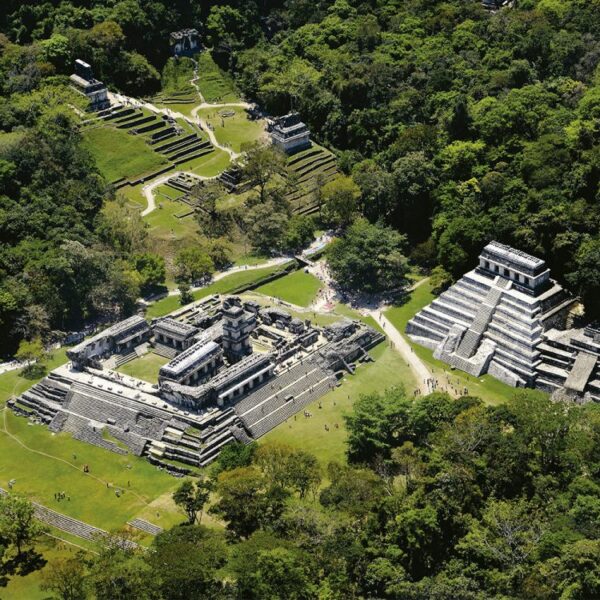
Archaeological Sites in Chiapas
In Chiapas the forests and the jungle are a beauty, spectacular settings for archaeological sites. The incredible nature that accompanies many of these areas is a plus. Visits to archaeological sites are part of nature tourism, due to the opportunity to walk around diverse natural environments. In several of these places you can see animals, or hear them. They are places that also give us the opportunity to connect with nature, and that hand in hand with culture is an excellent combination.… Read More
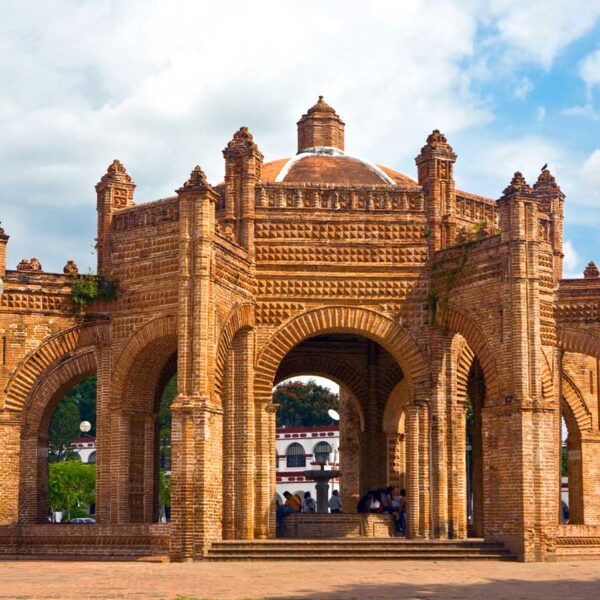
Magical Towns in Chiapas
Chiapas has 4 Magical Towns: San Cristóbal de Las Casas, Chiapa de Corzo, Comitán de Dominguez and Palenque, this recognition is given to the localities that have a special charm and unique symbolic attributes that allow to highlight the character and identity of the town, which they are manifested through their cultural heritage. Some of these characteristics can be: history, architecture, gastronomy and crafts, making your stay a magical moment.… Read More
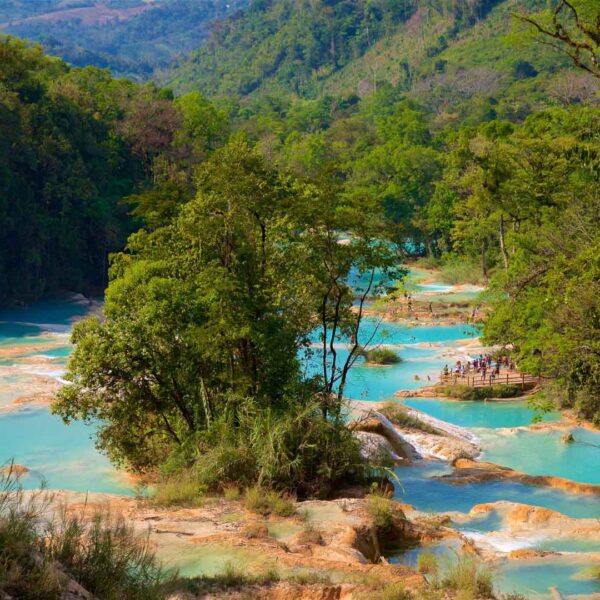
Tapachula and Tonala
Tapachula and Tonalá will amaze you with their beautiful buildings, their people and their traditions, colonial monuments, and breathtaking landscapes. Tapachula is also known as “La Perla del Soconusco” (The Pearl of Soconusco), it is a modern city with beautiful buildings built in a classic style. Located just next to the border with Guatemala, almost at the foot of the volcano Tacaná. Tonalá is a city in the southwest of Chiapas and head of the IX Istmo-Costa region; considered the third city in economic importance of the state; It is located in the transition of the Pacific Coastal Plain and the Sierra Madre de Chiapas.… Read More
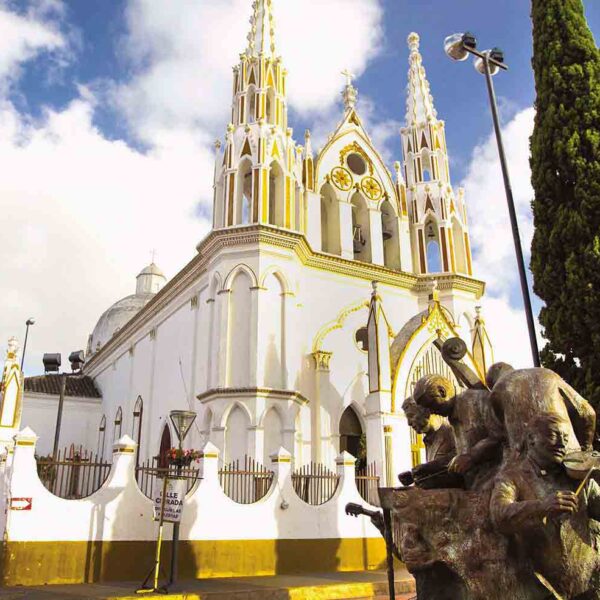
Tuxtla Gutierrez
It is the capital city of the State of Chiapas. Its climate is hot and semi-humid. Tuxtla Gutiérrez is a modern city where culture and traditions of Chiapas blend together. The streets in Tuxtla contain a combination of past and present. It is a beautiful city surrounded by lush vegetation. In downtown there is the Central Park and the beautiful Marimba Park. During the evenings you can stroll around this park and enjoy the marimba music played at the gazebo. There are many natural wonders nearby Tuxtla and the city offers very good touristic infrastructure, but most of all, the city offers the warm and kindness of the people.… Read More
Guided Tours in CHIAPAS
Flights & Hotels in CHIAPAS
More Tourist Attractions in MEXICO

Traditions in Mexico
It is practically impossible to make a meticulous, and above all, accurate selection of the places to visit in Mexico. Each place that our country houses is unique and beautiful in its own way. Mexico, with its nearly 2 million km², has a large number of scenarios to offer, as well as endless activities to do. Do not lose your way and enter the places to visit in Mexico. In Mexico, apart from the beaches and its famous archaeological sites, there are many other really interesting sites and activities that you should know. In the surroundings of the main cities you will find places full of culture and tradition, where you can spend relaxing, interesting and fun vacations. On your trip through Mexico you cannot stop obtaining souvenirs, the crafts that are made here are of the highest quality and recognized worldwide. A shopping tour cannot be missed.… Read More

Ecotourism and Adventure
Mexico is one of the best countries for Ecotourism as it has a great variety of flora and fauna, as well as a large number of refuges for extraordinary species. You can enjoy recreational activities of appreciation and knowledge of nature through contact with it, such as: stargazing, observation of natural attractions, wildlife and bird watching. Throughout México there are more than 176 protected natural areas, 5 of them considered by UNESCO as Natural Heritage of Humanity. Just for this and much more, we believe that Mexico is a Paradise for Ecotourism.… Read More

States Of Mexico
Mexico has an incredible diversity of landscapes, where the beauty of its beaches, internationally recognized, stands out. In its vast territory of coasts, there are beaches of unparalleled beauty, and colorful landscapes. A large network of first-class hotels and tourist services is available to visitors to these beaches. Mexico is also mystical places, dotted with archaeological testimonies inherited from its original inhabitants. Monuments made by the Mayas, Aztecs and Toltecs are located in magical landscapes, like lighthouses in an ocean of natural beauty. They offer visitors buildings that tell their history, and museums that collect their cultural heritage. And that keep alive ancestral traditions, in ceremonies and festivals, where you can enjoy cultural activities and entertainment.… Read More

Magical Towns
A Magical Town is a place with symbols and legends, towns with history that in many cases have been the scene of transcendent events for our country, they are places that show the national identity in each of its corners, with a magic that emanates from its attractions ; visiting them is an opportunity to discover the charm of Mexico. The Magical Towns Program contributes to revalue a set of populations in the country that have always been in the collective imagination of the nation and that represent fresh and varied alternatives for national and foreign visitors. A town that through time and in the face of modernity, has conserved, valued and defended its historical, cultural and natural heritage; and manifests it in various expressions through its tangible and intangible heritage. A Magical Town is a town that has unique, symbolic attributes, authentic stories, transcendent events, everyday life, which means a great opportunity for tourist use, taking into account the motivations and needs of travelers.… Read More

Beaches
On the Beaches of Mexico you can immerse yourself in the intense blue ocean of the Pacific bays, sunbathe on the shore of the warm and transparent waves of the Caribbean Sea in Quintana Roo or even rest on the beautiful coasts of the Gulf of Mexico. Mexican beaches hide wonderful secrets for the traveler. By visiting them, in addition to enjoying the excellent climate and water activities, you can discover splendid archaeological sites and interesting colonial cities without traveling long distances.… Read More

Capital Cities
Folklore, gastronomy, literary culture, art and exhibitions, is what you will find in the capitals of the states of Mexico. To the north, colonial Mexico, Puebla, Guadalajara, Guanajuato, the Sonoran desert and the California peninsula. To the east Veracruz and the gulf. To the west Acapulco, Oaxaca and Tuxtla Gutiérrez. And to the south the Riviera Maya and the pyramids of Chichén-Itzá, Tulúm and Cobá in Yucatán, Palenque in Chiapas, the cenotes, and the Central American jungles.… Read More

Gastronomy
The Gastronomy of Mexico has a great diversity of typical dishes, which is why it was recognized by UNESCO as Intangible Heritage of Humanity. The basic and representative ingredients of Mexican dishes are: corn, coriander, chili, beans, piloncillo, nopal and tomato. Mexican cuisine is also characterized by its sauces, which serve as an accompaniment to traditional dishes, prepared based on spices.… Read More

Archaeological Sites
The Archaeological Zones are the cultural past of every Mexican. You will be amazed at the ambient, nature and the environment that surrounds them. Climbing to the top or being around it will take us back in time to admire every detail. México is a country of culture and traditions, many of which we have inherited from the pre-Hispanic inhabitants of this vast territory, although it is true that there were more settlements in the central and southern part of the country, it is also possible to find some archaeological remains in the north.
… Read More

